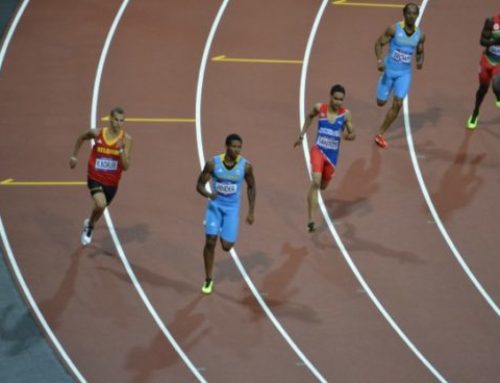5 Dynamic Drills to Build Sprinting Speed
As a coach and a runner, I understand the value of dynamic drills for both sprinting speed and power. However, I am always surprised when athletes—especially those who have been in the running game for some time—don’t understand why dynamic drills are essential for optimum performance.
The long and short of it is this: The movements an athlete works through in dynamic drills mimic each segment of movement in the sprint itself. Additionally, they aid in mobility and “muscle memory”—which is to say, the more comfortable an athlete is in a certain position or specific movement, the more natural it will feel when applied during a big race.
RELATED: Get Faster With This Sprint Form Checklist
According to USA Track & Field, there are five primary biomotor abilities every sprinter must work on in training: speed, strength, endurance, flexibility and coordination. Dynamic drills not only strengthen these abilities for a sprinter, they also help develop agility and mobility. For example, a popular dynamic drill is Hurdle Overs. It has several variations, but they all serve a specific purpose. When athletes lift their legs over the hurdle, it opens up their hip flexors, stretches their muscles and forces core stabilization, while simultaneously allowing them to feel the often unnoticed shifting of the hips mid-sprint.
There are many dynamic drills an athlete can perform, and each serves a specific purpose. They include acceleration drills to build the drive phase of the sprint; start drills to become comfortable exploding out of the blocks; and speed drills to build the swiftness necessary to win.
RELATED: How to Run a Faster 100-Meter Sprint
Below are five dynamic drills every sprinter should be sure to incorporate into his or her weekly workouts.
1. A-Skips
This simple yet effective movement is great for priming the body for explosive movement. The Skip exaggerates that push-off force from the ground at the ball of the foot. When you do this drill, it’s important to maintain dorsiflexion in your foot as you raise it to your opposite knee. Keep an erect torso and swing your hands in opposition to your legs. Begin by marching slowly, feeling out each portion of the drill. Once you have it down, proceed to the Skip.
2. Wall Drills
This is another great drill to promote explosive movement. Like the A-Skip, the leg must come up at a 90-degree angle. The difference is that you are leaning forward. The power line—spine, hip and leg alignment—should be at a 45-degree angle. Hands should be placed firmly against the wall. Heels should be slightly off the ground, just enough to slide a piece of paper underneath. Engage your core the entire time, and don’t allow your hips to slip back. Progression of the drill moves from a simple March through to a 4-count switch. Stay on the balls of your feet and maintain dorsiflexion of the foot.
RELATED: Sprint Faster With a Stronger Core
3. Hurdle Mobility Drills
These drills serve as a great warm-up for both hurdlers and sprinters. My two favorite variations are the lead leg and the alternating leg. Both do an excellent job of opening up the hip flexors, which aids mobility. This is usually a bigger issue for female athletes, so I have my girls run through these drills every day. Another reason hurdle mobility drills are great for all athletes is that core stabilization is needed to execute the movements properly. Maintain an erect posture and lift your leg high to swing it over the hurdle. Your hips should not pivot. Go through the drill slowly at first. As you become more comfortable with the movement, pick up the pace.
4. Bench Jumps
Bench Jumps are great for preparing the body for ballistic movement, especially coming out of the blocks. Place one foot on the bench at the ball of your foot. Push off in an upward motion, swinging your arms in opposition. Point your toe in midair, then flex your foot before landing back on the bench. Do this 10 to 15 times for each leg. Due to the height they can get when pushing off the bench, this movement is always a little nerve-wracking for my girls at the beginning of the season; so I start them out on shorter platforms until they are comfortable with the drill.
5. Hill Runs
This classic drill is great for both sprinters and endurance runners. Hill Runs are essential to prep the body for the drive phase of the sprint, but they’re also great for building power for endurance runners in their final kick. Hill Runs are best done on soft surfaces such as grass and dirt, but they can also be simulated on a treadmill. Lean slightly into the hill both going up and coming down. Stabilize your core and maintain the power line like you did with the Wall Drill. Hill Runs can be done on their own or as a warm-up to a main set.
[cf]skyword_tracking_tag[/cf]RECOMMENDED FOR YOU
MOST POPULAR
5 Dynamic Drills to Build Sprinting Speed
As a coach and a runner, I understand the value of dynamic drills for both sprinting speed and power. However, I am always surprised when athletes—especially those who have been in the running game for some time—don’t understand why dynamic drills are essential for optimum performance.
The long and short of it is this: The movements an athlete works through in dynamic drills mimic each segment of movement in the sprint itself. Additionally, they aid in mobility and “muscle memory”—which is to say, the more comfortable an athlete is in a certain position or specific movement, the more natural it will feel when applied during a big race.
RELATED: Get Faster With This Sprint Form Checklist
According to USA Track & Field, there are five primary biomotor abilities every sprinter must work on in training: speed, strength, endurance, flexibility and coordination. Dynamic drills not only strengthen these abilities for a sprinter, they also help develop agility and mobility. For example, a popular dynamic drill is Hurdle Overs. It has several variations, but they all serve a specific purpose. When athletes lift their legs over the hurdle, it opens up their hip flexors, stretches their muscles and forces core stabilization, while simultaneously allowing them to feel the often unnoticed shifting of the hips mid-sprint.
There are many dynamic drills an athlete can perform, and each serves a specific purpose. They include acceleration drills to build the drive phase of the sprint; start drills to become comfortable exploding out of the blocks; and speed drills to build the swiftness necessary to win.
RELATED: How to Run a Faster 100-Meter Sprint
Below are five dynamic drills every sprinter should be sure to incorporate into his or her weekly workouts.
1. A-Skips
This simple yet effective movement is great for priming the body for explosive movement. The Skip exaggerates that push-off force from the ground at the ball of the foot. When you do this drill, it’s important to maintain dorsiflexion in your foot as you raise it to your opposite knee. Keep an erect torso and swing your hands in opposition to your legs. Begin by marching slowly, feeling out each portion of the drill. Once you have it down, proceed to the Skip.
2. Wall Drills
This is another great drill to promote explosive movement. Like the A-Skip, the leg must come up at a 90-degree angle. The difference is that you are leaning forward. The power line—spine, hip and leg alignment—should be at a 45-degree angle. Hands should be placed firmly against the wall. Heels should be slightly off the ground, just enough to slide a piece of paper underneath. Engage your core the entire time, and don’t allow your hips to slip back. Progression of the drill moves from a simple March through to a 4-count switch. Stay on the balls of your feet and maintain dorsiflexion of the foot.
RELATED: Sprint Faster With a Stronger Core
3. Hurdle Mobility Drills
These drills serve as a great warm-up for both hurdlers and sprinters. My two favorite variations are the lead leg and the alternating leg. Both do an excellent job of opening up the hip flexors, which aids mobility. This is usually a bigger issue for female athletes, so I have my girls run through these drills every day. Another reason hurdle mobility drills are great for all athletes is that core stabilization is needed to execute the movements properly. Maintain an erect posture and lift your leg high to swing it over the hurdle. Your hips should not pivot. Go through the drill slowly at first. As you become more comfortable with the movement, pick up the pace.
4. Bench Jumps
Bench Jumps are great for preparing the body for ballistic movement, especially coming out of the blocks. Place one foot on the bench at the ball of your foot. Push off in an upward motion, swinging your arms in opposition. Point your toe in midair, then flex your foot before landing back on the bench. Do this 10 to 15 times for each leg. Due to the height they can get when pushing off the bench, this movement is always a little nerve-wracking for my girls at the beginning of the season; so I start them out on shorter platforms until they are comfortable with the drill.
5. Hill Runs
This classic drill is great for both sprinters and endurance runners. Hill Runs are essential to prep the body for the drive phase of the sprint, but they’re also great for building power for endurance runners in their final kick. Hill Runs are best done on soft surfaces such as grass and dirt, but they can also be simulated on a treadmill. Lean slightly into the hill both going up and coming down. Stabilize your core and maintain the power line like you did with the Wall Drill. Hill Runs can be done on their own or as a warm-up to a main set.















